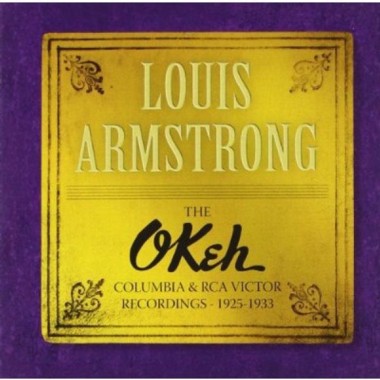In the liner notes to the new Legacy box set of Louis Armstrong’s Okeh recordings, Armstrong House Museum archivist Ricky Riccardi declares the discs “the most important recordings of the 20th century.” Riccardi may be a slightly biased observer, but that hyperbolic statement may not really be hyperbole.
That’s because Armstrong was the quintessential and, arguably, most important practitioner of jazz when the word and the sounds were new, and when pop music and jazz were not separate genres. Many of the recordings in the set are the work of two iterations of Armstrong’s bands, the Hot Five and the Hot Seven, and include all the vinyl Armstrong released between 1925 and 1933.
In those days, the extended improvisations common to later, less accessible brands of jazz were largely absent, at least in the studio. The tunes are three-minute compositions of the sort now common outside of jazz but rare within the genre. Almost all are exuberant, hummable and full of energy. This was, after all, the pop music of its day, the upbeat answer to things like classical music. It was also considered the music of African-Americans, and therefore inherently edgyfor most white audiences. Add all those elements together with the stunning and masterful musicianship on display, and it’s easy to argue that these recordings are indeed the product of a watershed moment in musical history.
After Armstrong took the music of his native New Orleans and spread it far and wide, things really did change. Until rock and roll’s arrival in the ’50s, jazz bands rode the vanguard of musical experimentation, and did so while enjoying widespread popularity. It’s a feat that, outside of a few outliers like Radiohead’s Kid A, is rarely replicated today.
Put with the Armstrong recordings another newly released box set, and you can bookend the Big Band Era. That set includes the complete Columbia studio albums of 1951-58 by Duke Ellington, master of another kind of jazz. By the ’50s, Ellington’s jazz had evolved from the upbeat pop nuggets of the ’20s and ’30s to something far more expansive, an orchestral conception of the music. His own compositions combine with works penned by Billy Strayhorn, who was the primary creator of many of the tunes now associated with Ellington, to create a sprawling, nearly classical sound. In an era when big bands were becoming an endangered species, soon to be pushed near extinction by rock and roll, Ellington carried the torch for a sophisticated and purely American form. His jazz was more a counterpoint to classical than a striving for popularity for its own sake. Somehow, he did manage pop appeal all the same, especially with hits like “Satin Doll” and “Take the A Train.”
A major highlight of the set is the disc Black, Brown and Beige, a re-recording of a major conceptual piece Ellington composed in the 1940s. This version features the powerhouse vocals of Mahalia Jackson. It’s a remarkable straddling of eras, combining a very 1940s big band sound with violin and with smooth melodies right out of the 1920s, when Ellington held court in Harlem. The result is unusual—it’s at once orchestral, classical, jazzy, and even folksy. The combination is, somehow, esentially American.
The combination of these two new box sets is likewise singular, a tour of the beginning and end of the era when jazz reigned supreme in the American musical imagination. Listen to pieces of one, then the other, and with the wide range of sounds and ideas on display, it’s surprising to consider that both musicians are considered masters of the same genre.•



